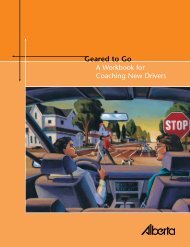Commercial driver's guide to operation, safety and licensing
Commercial driver's guide to operation, safety and licensing
Commercial driver's guide to operation, safety and licensing
Create successful ePaper yourself
Turn your PDF publications into a flip-book with our unique Google optimized e-Paper software.
Parking<br />
Always select a safe place <strong>to</strong> park the<br />
vehicle. Set the parking brake in the<br />
trac<strong>to</strong>r. Do not use the trailer h<strong>and</strong> valve<br />
<strong>to</strong> hold a parked unit. Put the transmission<br />
in the lowest forward or reverse gear (if<br />
applicable). If the vehicle has a two-speed<br />
axle, put the axle in low range.<br />
Properly block the wheels using wheel<br />
chocks or square blocks. The minimum<br />
size for the square blocks should be 15<br />
centimetres by 15 centimetres.<br />
Do not expect the transmission <strong>to</strong> do<br />
the work of securing the vehicle. Always<br />
use the vehicle’s parking brake system <strong>and</strong><br />
wheel blocks.<br />
Parking on a hill<br />
The law requires that the wheels of a<br />
parked vehicle be no more than 50<br />
centimetres from the curb. When parked,<br />
the vehicle must be left in low gear or<br />
reverse for a manual transmission or<br />
park for an au<strong>to</strong>matic transmission. Have<br />
the park brake engaged. The following<br />
information applies <strong>to</strong> vehicles parked<br />
on the right-h<strong>and</strong> side of the road. For<br />
vehicles parked on the left-h<strong>and</strong> side of the<br />
road (one-way), turn the front wheels in the<br />
opposite direction.<br />
• For parking downhill, with or without a<br />
curb, the front wheels should always be<br />
turned <strong>to</strong> the right.<br />
• For parking uphill with a curb, the<br />
front wheels should always be turned<br />
<strong>to</strong> the left.<br />
• For parking uphill without a curb,<br />
trac<strong>to</strong>r-trailer units with one articulation<br />
point should always have the front<br />
wheels turned <strong>to</strong> the left.<br />
Note: If there is a curb, allow the vehicle<br />
<strong>to</strong> roll <strong>to</strong> the point where the front wheels<br />
are making contact with the curb before<br />
setting the park brake. This helps <strong>to</strong><br />
prevent the vehicle from jumping the curb<br />
if the vehicle starts <strong>to</strong> move.<br />
Reversing<br />
• When reversing a semi-trailer, turn the<br />
steering wheel in the opposite direction<br />
<strong>to</strong> where you want the trailer <strong>to</strong> go.<br />
Another method is <strong>to</strong> place your h<strong>and</strong><br />
on the bot<strong>to</strong>m of the steering wheel <strong>and</strong><br />
move your h<strong>and</strong> in the same direction<br />
that you want the trailer <strong>to</strong> go. The<br />
trac<strong>to</strong>r must follow an S-shape in order<br />
<strong>to</strong> bring the trailer around smoothly.<br />
• Always reverse the vehicle slowly <strong>and</strong><br />
use both the rear view mirrors. Never<br />
forget that there is always a blind spot<br />
directly behind the vehicle that is not<br />
visible in the mirrors.<br />
• Avoid unnecessary reversing by<br />
planning ahead.<br />
• Sound the horn as a <strong>safety</strong> precaution<br />
before reversing. Repeat at least once<br />
for every vehicle length reversed.<br />
• If possible, ask someone <strong>to</strong> act as<br />
a <strong>guide</strong> <strong>and</strong> establish h<strong>and</strong> signals<br />
between the driver <strong>and</strong> the <strong>guide</strong>. The<br />
<strong>guide</strong> must be able <strong>to</strong> see the path<br />
the vehicle is taking. The driver must<br />
be able <strong>to</strong> see the <strong>guide</strong>. S<strong>to</strong>p if you<br />
cannot see the <strong>guide</strong>.<br />
• Remember that even with a <strong>guide</strong>,<br />
the driver is still responsible for all<br />
movements of the vehicle.<br />
50 A <strong>Commercial</strong> Driver’s Guide <strong>to</strong> Operation, Safety <strong>and</strong> Licensing




